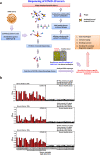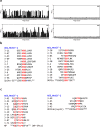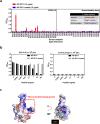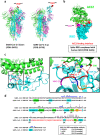Identification of COVID-19 B-cell epitopes with phage-displayed peptide library
- PMID: 34098950
- PMCID: PMC8182997
- DOI: 10.1186/s12929-021-00740-8
Identification of COVID-19 B-cell epitopes with phage-displayed peptide library
Abstract
Background: Coronavirus disease 19 (COVID-19) first appeared in the city of Wuhan, in the Hubei province of China. Since its emergence, the COVID-19-causing virus, SARS-CoV-2, has been rapidly transmitted around the globe, overwhelming the medical care systems in many countries and leading to more than 3.3 million deaths. Identification of immunological epitopes on the virus would be highly useful for the development of diagnostic tools and vaccines that will be critical to limiting further spread of COVID-19.
Methods: To find disease-specific B-cell epitopes that correspond to or mimic natural epitopes, we used phage display technology to determine the targets of specific antibodies present in the sera of immune-responsive COVID-19 patients. Enzyme-linked immunosorbent assays were further applied to assess competitive antibody binding and serological detection. VaxiJen, BepiPred-2.0 and DiscoTope 2.0 were utilized for B-cell epitope prediction. PyMOL was used for protein structural analysis.
Results: 36 enriched peptides were identified by biopanning with antibodies from two COVID-19 patients; the peptides 4 motifs with consensus residues corresponding to two potential B-cell epitopes on SARS-CoV-2 viral proteins. The putative epitopes and hit peptides were then synthesized for validation by competitive antibody binding and serological detection.
Conclusions: The identified B-cell epitopes on SARS-CoV-2 may aid investigations into COVID-19 pathogenesis and facilitate the development of epitope-based serological diagnostics and vaccines.
Keywords: B-cell epitope; COVID-19; Diagnostic tool; Phage-displayed peptides; SARS-CoV-2; Serological detection.
Conflict of interest statement
The authors declare no competing interest.
Figures




Similar articles
-
Bioinformatics analysis of epitope-based vaccine design against the novel SARS-CoV-2.Infect Dis Poverty. 2020 Jul 10;9(1):88. doi: 10.1186/s40249-020-00713-3. Infect Dis Poverty. 2020. PMID: 32741372 Free PMC article.
-
Mining of linear B cell epitopes of SARS-CoV-2 ORF8 protein from COVID-19 patients.Emerg Microbes Infect. 2021 Dec;10(1):1016-1023. doi: 10.1080/22221751.2021.1931465. Emerg Microbes Infect. 2021. PMID: 34003073 Free PMC article.
-
In silico discovery of antigenic proteins and epitopes of SARS-CoV-2 for the development of a vaccine or a diagnostic approach for COVID-19.Sci Rep. 2020 Dec 28;10(1):22387. doi: 10.1038/s41598-020-79645-9. Sci Rep. 2020. PMID: 33372181 Free PMC article.
-
Development of multi-epitope peptide-based vaccines against SARS-CoV-2.Biomed J. 2021 Mar;44(1):18-30. doi: 10.1016/j.bj.2020.09.005. Epub 2020 Oct 1. Biomed J. 2021. PMID: 33727051 Free PMC article. Review.
-
Experimental Identification of Immuno- dominant B-cell Epitopes from SARS-CoV-2.Chimia (Aarau). 2021 Apr 28;75(4):276-284. doi: 10.2533/chimia.2021.276. Chimia (Aarau). 2021. PMID: 33902795 Review.
Cited by
-
Monoclonal antibodies against S2 subunit of spike protein exhibit broad reactivity toward SARS-CoV-2 variants.J Biomed Sci. 2022 Dec 22;29(1):108. doi: 10.1186/s12929-022-00891-2. J Biomed Sci. 2022. PMID: 36550570 Free PMC article.
-
B.1.1.7 (Alpha) variant is the most antigenic compared to Wuhan strain, B.1.351, B.1.1.28/triple mutant and B.1.429 variants.Front Microbiol. 2022 Aug 12;13:895695. doi: 10.3389/fmicb.2022.895695. eCollection 2022. Front Microbiol. 2022. PMID: 36033846 Free PMC article.
-
Detection of Antibodies against Endemic and SARS-CoV-2 Coronaviruses with Short Peptide Epitopes.Vaccines (Basel). 2023 Aug 23;11(9):1403. doi: 10.3390/vaccines11091403. Vaccines (Basel). 2023. PMID: 37766081 Free PMC article.
-
The Breadth of Bacteriophages Contributing to the Development of the Phage-Based Vaccines for COVID-19: An Ideal Platform to Design the Multiplex Vaccine.Int J Mol Sci. 2023 Jan 12;24(2):1536. doi: 10.3390/ijms24021536. Int J Mol Sci. 2023. PMID: 36675046 Free PMC article. Review.
-
Epitopes and Mimotopes Identification Using Phage Display for Vaccine Development against Infectious Pathogens.Vaccines (Basel). 2023 Jun 29;11(7):1176. doi: 10.3390/vaccines11071176. Vaccines (Basel). 2023. PMID: 37514992 Free PMC article. Review.
References
-
- Center for Systems Science and Engineering (CSSE) at JHU. COVID-19 Dashboard. https://coronavirus.jhu.edu/map.
-
- Zhou P, Yang XL, Wang XG, Hu B, Zhang L, Zhang W, Si HR, Zhu Y, Li B, Huang CL, Chen HD, Chen J, Luo Y, Guo H, Jiang RD, Liu MQ, Chen Y, Shen XR, Wang X, Zheng XS, Zhao K, Chen QJ, Deng F, Liu LL, Yan B, Zhan FX, Wang YY, Xiao GF, Shi ZL. A pneumonia outbreak associated with a new coronavirus of probable bat origin. Nature. 2020;579(7798):270–273. doi: 10.1038/s41586-020-2012-7. - DOI - PMC - PubMed
-
- Lu R, Zhao X, Li J, Niu P, Yang B, Wu H, Wang W, Song H, Huang B, Zhu N, Bi Y, Ma X, Zhan F, Wang L, Hu T, Zhou H, Hu Z, Zhou W, Zhao L, Chen J, Meng Y, Wang J, Lin Y, Yuan J, Xie Z, Ma J, Liu WJ, Wang D, Xu W, Holmes EC, Gao GF, Wu G, Chen W, Shi W, Tan W. Genomic characterisation and epidemiology of 2019 novel coronavirus: implications for virus origins and receptor binding. Lancet. 2020;395(10224):565–574. doi: 10.1016/S0140-6736(20)30251-8. - DOI - PMC - PubMed
MeSH terms
Substances
Grants and funding
LinkOut - more resources
Full Text Sources
Medical
Molecular Biology Databases
Miscellaneous

